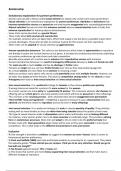Lecture notes
AQA A level psychology year 2 relationships revision notes
- Year 2 relationships - All material is covered in these notes - AO1 in an extensive amount with A03 - Evaluations are all in PEEL format - All possible 16 markers are covered
[Show more]





